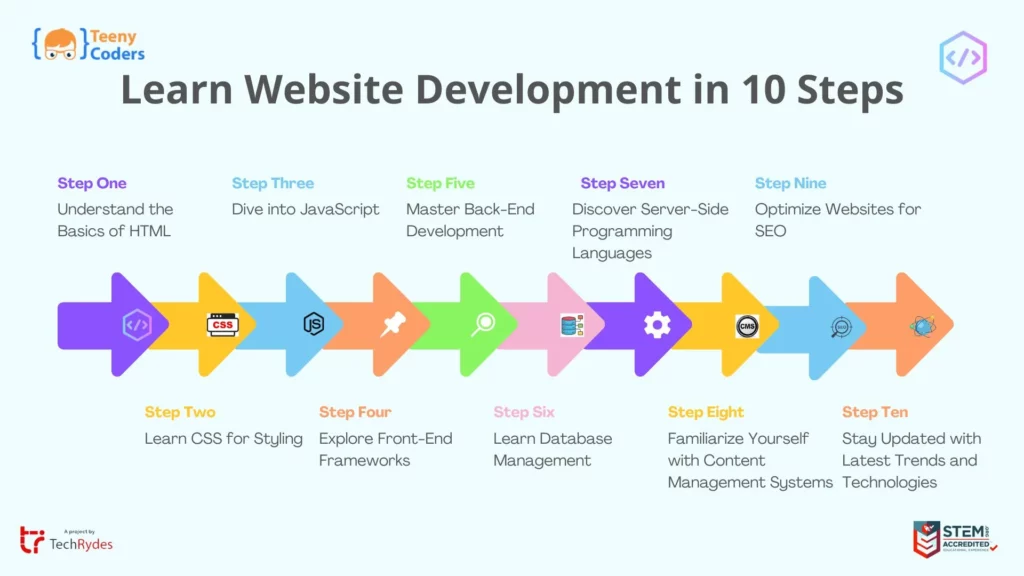Website development has been a warm topic for the last couple of years. Not everyone can get his/her name among the best website developers just because they didn’t follow a path and didn’t work on a goal. If you don’t know your destination, then you’ll never know how much and for how long your effort is needed. Even though the market is concentrated with website developers but still there is an opportunity for you to get your name written among the best website developers since this skill is still valuable. In this article, we will guide you through the process of learning website development in 10 steps. By following these steps, you’ll be well on your way to creating your own websites and exploring the exciting world of web development.
Before you start with the first step of website development. You need to choose the right IDE (Integrated Development Environment) or a compiler to start developing your website. Compilers work as a medium to join all the chunks of code to compile them into an eye-catching result. The question here is how to choose the right IDE for website development.
Step 1: Understand the Basics of HTML
HTML (Hypertext Markup Language) is the foundation of any website. It defines the structure and content of web pages. Start by learning HTML tags, elements, attributes, and how they all work together to create web pages.
Step 2: Learn CSS for Styling
CSS (Cascading Style Sheets) allows you to add style and visual appeal to your web pages. Dive into CSS selectors, properties, and values to learn how to manipulate the appearance of HTML elements.
Step 3: Dive into JavaScript
JavaScript is a powerful programming language that brings interactivity and dynamic functionality to websites. Learn JavaScript fundamentals, such as variables, functions, loops, and conditionals, to enhance the user experience.
Step 4: Explore Front-End Frameworks
Front-end frameworks like Bootstrap and React provide pre-built components and tools to streamline web development. Explore these frameworks to create responsive and visually appealing websites efficiently.
Step 5: Master Back-End Development
Back-end development involves server-side programming and handling data. Learn a back-end language such as Python, Ruby, or PHP to build dynamic web applications and interact with databases.
Step 6: Learn Database Management
Databases store and manage website data. Familiarize yourself with popular databases like MySQL or MongoDB. Learn how to design database schemas, perform CRUD operations, and ensure data security.
Step 7: Discover Server-Side Programming Languages
Server-side programming languages like Node.js enable you to build scalable and efficient web applications. Understand concepts like event-driven programming and asynchronous I/O to develop high-performance websites.
Step 8: Familiarize Yourself with Content Management Systems
Content Management Systems (CMS) like WordPress and Drupal simplify website creation and management. Explore CMS platforms to build websites without extensive coding knowledge.
Step 8: Familiarize Yourself with Content Management Systems
Content Management Systems (CMS) like WordPress and Drupal simplify website creation and management. Explore CMS platforms to build websites without extensive coding knowledge.
Step 9: Optimize Websites for SEO
Search Engine Optimization (SEO) helps improve website visibility and ranking on search engines. Learn SEO techniques, including keyword research, on-page optimization, and link building, to attract organic traffic.
Step 10: Stay Updated with Latest Trends and Technologies
Website development is a constantly evolving field. Stay updated with the latest trends, frameworks, and technologies. Follow industry blogs, attend webinars, and engage with the developer community to enhance your skills.
Conclusion
Learning website development is an exciting journey that empowers you to create dynamic and engaging websites. By following these 10 steps, you can acquire the necessary skills and knowledge to kick-start your web development career or embark on personal projects.
FAQs
1. Is website development difficult to learn?
Website development can be challenging at first, but with dedication and practice, you can grasp the concepts and become proficient.
2. How long does it take to learn website development?
The time it takes to learn website development varies depending on your dedication, prior knowledge, and the complexity of the projects you undertake. It can range from a few months to several years.
3. Do I need to know programming languages to build a website?
Knowing programming languages such as HTML, CSS, and JavaScript is essential for building websites from scratch. However, using CMS platforms like WordPress allows you to create websites without extensive coding knowledge.
4. Can I learn website development online?
Yes, there are numerous online resources, tutorials, and courses available to learn website development. Online platforms offer flexibility and a wealth of learning materials.
5. What are the career prospects in website development?
Website development offers various career opportunities. You can be a full stack web developer, a front-end developer or back-end developer. The demand for skilled web developers continues to grow as businesses increasingly rely on online presence. Since the trends have been shifting over the past few years demand for these skilled people has increased.
Recommendations:
Website development offers various career opportunities. You can be a full stack web developer, a front-end developer or back-end developer. The demand for skilled web developers continues to grow as businesses increasingly rely on online presence. Since the trends have been shifting over the past few years demand for these skilled people has increased.


